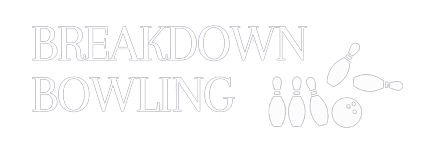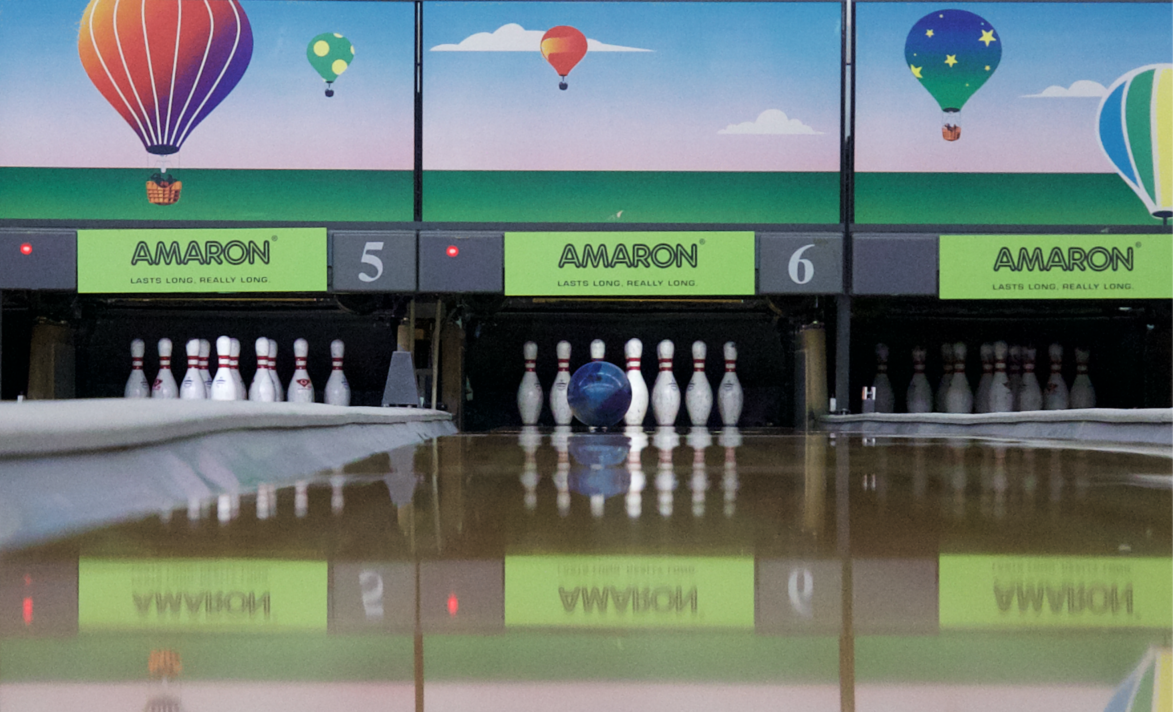0-9
A
- Abralon pad
- A rough fabric used to sand the surface of the ball. Ratings are available for each pad (E.g. 2000, 1000) which denote the specific degree of roughness
- Approach
- 1. The platform on the lane which the bowler walks on before the foul line.
2. The motion the bowler goes through from setting up with the ball, to releasing the ball.
- Asymmetrical
- Describes a bowling ball core which tends to be more oddly-shaped and unstable when it rolls. More accurately, the radius of gyration (RG) of the Y (high RG) and Z (intermediate RG) axes differ by more than 5%
B
- Back end
- The last 10-15 feet of the lane which is usually dry. Also used to refer to ball motion in this part of the lane
- Breakdown
- The process by which balls repeatedly roll over the oil on the lanes, causing the total volume of oil in those specific parts to decrease, and creating more friction
- Breakpoint
- Point on the lane at which the bowling ball changes direction
- Bucket
- Refers to the 3-5-6-9 and 2-4-5-8 pin leaves
C
- Carry-down
- Phenomenon during lane transition where the ball tends to skid more. This happens because balls pick up oil from the oilier, front part of the lane, and leave them on the drier, back part of the lane
- Connection
- Two or more consecutive strikes
- Core
- The dense inner most component of the ball that can take various shapes and sizes and is used to influence the motion of the ball. Also known as ‘weight block’
D
- Dead wood
- A pin that has fallen on the lane or into the gutter and is unable to be cleared by the sweeper
- Drilling
- The positions of the finger and thumb holes in the ball relative to other technical measures such as the ball’s PAP. Also known as layout
E
- Entry angle
- The angle from a line parallel to the boards at which the ball makes contact with the head pin in the pocket
F
- Follow through
- The outward and upward motion of the bowler’s arm after the release driven by the momentum from the delivery
- Forward roll
- The component of rotation of the ball that has its axis parallel to the foul line
- Foul
- When any part of the bowler (other than the ball) lands beyond the foul line, regardless of whether the foul line buzzer is activated. The bowler receives 0 for the shot
- Foundation frame
- The 9th frame of the game, which sets up the last frame and provides the potential to increase pinfall by a large number
G
- Greek Church
- A 4-6-7-9-10 or 4-6-7-8-10 split
- Gutter
- The two channels which run parallel on the left and right of the lane. If the ball lands in the gutter, the shot scores zero pins
- Gyration
- Rotation of the bowling ball that is not about its most stable axis
H
- Head pin
- Pin 1
- High pocket
- When the ball enters the pocket too close to the head pin
- House ball
- Bowling balls with pre-drilled finger and thumb holes available at most bowling alleys for casual bowlers to borrow and use
I
- Inside
- The area towards the left of the lane (for right-handed bowlers). For example if the lanes are too dry, the bowler may wish to move deeper inside
J
K
- Kingpin
- The central pin, pin 5
L
- Length
- Distance between the foul line and the breakpoint
M
- Match up
- How effectively a bowler’s style and strategy performs on the specific lane condition
- Messenger
- A pin that flies or rolls across the pin deck to knock down the last pin standing (usually a 7 or 10 pin) to strike
N
- Nine-pin tap
- A scoring format where any first shot that hits 9 pins or more counts as a strike
O
- Oil Pattern
- The distribution or shape in which oil is laid onto the lanes
P
- PBA
- Professional Bowlers Association, the organisation which governs professional bowlers internationally
- Par
- A base value used for keeping score easily, usually set at 200. The differences between the actual score and the par score will be added to the count. E.g. A score of 225 will have a par value of +25
- Patchy
- Informal term used to describe the lane having uneven regions of high and low volume of oil, causing inconsistent ball reaction
- The ideal position for a ball to make contact with the 10 pins in order to achieve a strike. It has been surveyed by the USBC to be the centre of Pin 1 and Pin 3 (board 17.5) for right-handed bowlers, or Pin 1 and Pin 2 for left-handed bowlers.
- Power step
- The second last step of the bowler’s approach used to provide momentum and coordinate the timing with the swing
- Push away
- The motion in the bowler’s delivery whereby the ball moves downwards from the resting position to begin the backswing
Q
- Qualifying
- The first stage of the tournament
R
- Release
- The motion of the hand through which the ball leaves it
- Revolution rate
- Known informally as ‘rev rate’, the number of full rotations a bowling ball can make in a fixed period of time, usually measured in revolutions per minute (RPM)
- Ringing 10
- The situation where the pin 6 flies around the 10 pin instead of hitting it directly. Usually occurs then the ball enters the pocket with too large an entry angle
- Roll out
- Phenomenon when a ball completes its acceleration and reaches a stable roll, but has not hit the pins yet, most often resulting in a weak shot
S
- Sand
- Using sandpaper or any other similarly rough material to make the surface of the ball rougher
- Sandbagging
- Intentionally bowling badly in order to get a future advantage. For example, bowling poorly in a league to get a higher handicap for future weeks
- Slide
- The last step in a bowler’s approach where the bowler moves with the smooth surface of the shoe in constant contact with the approach, rather than taking a normal step with the foot lifted
- Slipper
- Refers to the 2-8 or 3-9 pin leaves
- Spare
- The score recorded when a bowler requires 2 shots to hit all 10 pins in a frame. Scored as 10 + whatever the bowler hits in the next shot.
- Stepladder
- A competitive format in which 2-3 players bowl against each other, and the highest scorer advances to the next match, where they again bowl a single game against 1-2 players, until they reach the final match against the top ranked competitor. Usually the final stage of major tournaments.
- Surface
- The outermost layer of the bowling ball that can be modified. Used informally in ‘giving more surface’ to mean making the surface of the ball rougher
T
- Track
- Rings of oil around a bowling ball after it has been bowled showing the progression of the ball’s path where it contacts the lane
U
- USBC
- United States Bowling Congress, the organisation which governs the rules and standards of tenpin bowling in the USA. Many other national bowling organisations adopt the same rules as the USBC
- Urethane
- A material (polyurethane) used in the production of bowling balls, most commonly used to refer to balls whose coverstocks are made entirely with polyurethane, as opposed to reactive balls
V
- Volume
- The amount of oil that is applied to a lane, usually measured in mililitres
W
- Washout
- A pin leave that comprises at least the head pin, as well as a pair of non-adjacent pins. For example, 1-2-4-10
X
- X
- Symbol for a strike
Y
Z

